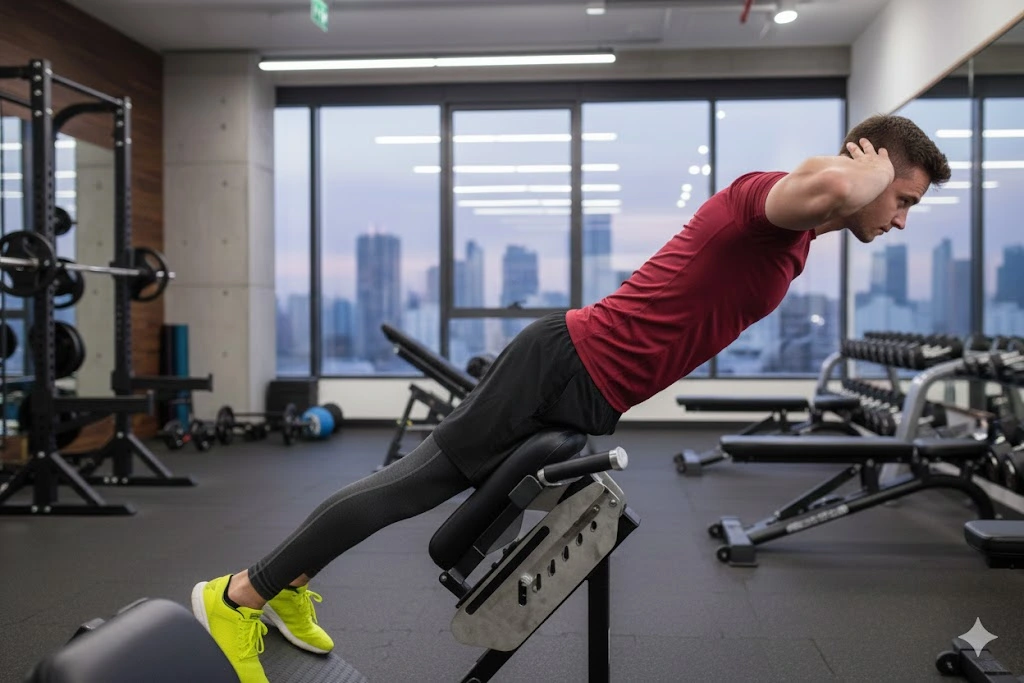Introduction
If you want stronger, broader shoulders and a powerful upper body that commands presence, the military press is your no-nonsense ticket to building strength. This isn’t just another gym lift, it’s a test of raw power, strict form, and total body control. Whether you are a beginner trying to master the basics or an experienced lifter looking to refine your overhead strength, the military press is one of the most effective compound movements you can perform.
Originally named for its use in military physical readiness tests, this movement has been a gold standard in strength training for decades. Its simplicity makes it easy to program, yet its demands make it a true challenge. You are not just working your shoulders, you are engaging your triceps, upper chest, traps, core, and even your glutes to stabilize the lift. Few exercises build upper-body pressing power as directly and efficiently as this one.
Whether your goal is strength, muscle growth, better posture, or just nailing a clean overhead lift, the military press deserves a permanent spot in your routine. In the following sections, we’ll break down the muscles it works, how to do it properly, variations like the seated and dumbbell military press, and the best alternatives to match your training style.
Table of Contents
Muscles Worked in the Military Press
- Anterior Deltoid – The front part of your shoulder; the primary muscle responsible for lifting the bar overhead.
- Lateral Deltoid – The side of your shoulder; helps stabilize and control the pressing movement.
- Triceps Brachii – Located at the back of the upper arm; assists in elbow extension during the press.
- Upper Trapezius – Upper neck and shoulder area; supports shoulder elevation and stability during lockout.
- Clavicular Head of Pectoralis Major (Upper Chest) – Assists with upward pressing from the chest area.
- Serratus Anterior – Runs along the rib cage; helps with scapular movement and shoulder blade control.
- Core Muscles (Abs & Obliques) – Stabilize the spine and prevent lower back overextension.
- Glutes – Keep the lower body tight and stable, preventing hip movement or swaying.
- Lower Back (Erector Spinae) – Provides spinal support and helps maintain posture under load.
How To Do a Military Press (Step-by-Step)
Executing the military press with proper form is essential not only for maximizing strength gains but also for preventing injury. It’s a demanding lift that requires full-body coordination, core control, and precision from start to finish. Here’s how to do it step by step:
1. Set Up Your Bar and Rack Height
Start by setting the barbell in a squat rack at about upper chest level. This allows you to unrack the bar without tiptoeing or squatting underneath it. Load the appropriate weight and ensure the bar is centered.
2. Stand with Feet Together and Grab the Bar
Position your feet close together, typically hip-width or slightly narrower, which is key to maintaining the strict nature of the military press. Grip the bar just outside shoulder-width, with your palms facing forward and wrists stacked directly over your elbows.
3. Unrack the Barbell
Step under the bar and rest it across the front of your shoulders, just above your collarbone. Take a deep breath, brace your core, and stand tall as you unrack the bar by pushing up and stepping back carefully.
4. Set Your Stance and Brace Your Core
Keep your glutes tight, legs locked, and abs engaged. Your spine should remain neutral avoiding arching your lower back. Lock your body from the waist down to create a stable foundation for the press.
5. Initiate the Press
Push the barbell straight up, keeping it close to your face. As the bar passes your head, slightly move your head and upper body forward so the bar continues in a vertical path over the middle of your foot. This movement is often described as “getting your head through the window.”
6. Lock Out at the Top
At the top of the movement, your arms should be fully extended overhead with the bar directly above your shoulders and midfoot. Your elbows should be straight, and your shoulder blades should rotate slightly to support the lift. Pause briefly to ensure full lockout and control.
7. Lower the Bar with Control
Slowly bring the barbell back down to the starting position on the front of your shoulders by reversing the path. Keep your core engaged and avoid crashing the bar down or bouncing it off your chest.
8. Reset and Repeat
Take another breath, re-brace your core, and perform the next rep. Maintain consistent posture and tempo throughout your set.
Military Press Tips for Better Performance
The military press may look straightforward, but refining your technique can make a huge difference in strength, control, and shoulder development. Here are practical tips to help you press more effectively and safely:
1. Brace Your Core Like You’re Taking a Punch:
One of the biggest mistakes lifters make is letting their lower back arch during the press. Prevent this by tightening your abs hard as if someone’s about to punch your stomach. A strong core keeps your spine neutral and reduces injury risk.
2. Squeeze Your Glutes to Lock Your Lower Body:
Your legs may not be actively lifting the weight, but they play a critical role in balance and control. Engage your glutes to prevent hip shifting or excessive leaning. This creates a solid base from the ground up.
3. Keep the Bar Close to Your Body:
The bar should travel in a straight, vertical line not forward or away from your face. Keeping it close helps maintain proper leverage and avoids unnecessary strain on your shoulders or lower back.
4. Move Your Head Slightly Back, Then Through:
As you press the bar up, tilt your head slightly back to let the bar pass, then push your head slightly forward once it clears your forehead. This keeps the bar path efficient and ensures it finishes directly over your center of gravity.
5. Use a Full Range of Motion:
Lower the bar to your upper chest and press it until your elbows are fully locked out. Cutting your range short limits strength development and increases the chance of muscle imbalances.
6. Warm Up Your Shoulders and Thoracic Spine:
Before jumping into heavy pressing, do some dynamic mobility work, shoulder circles, band pull-aparts, and thoracic extensions to prepare your joints and improve positioning during the lift.
7. Don’t Rush Your Progress:
Avoid ego lifting. Focus on clean, controlled reps with proper form before adding weight. Strength builds over time rushing only increases the risk of poor technique and injury.
8. Use Chalk for Grip, Not Wrist Wraps (At First):
Improving your natural grip strength is essential in early training. Use chalk to avoid slipping, but skip wrist wraps until you’re pushing heavier weights consistently and need added support.
9. Breathe With Purpose:
Inhale deeply before each rep to create intra-abdominal pressure, hold your breath as you press, and exhale at the top or during the descent. This breathing cycle reinforces stability.
10. Record Your Lifts to Check Form:
Filming your sets can reveal issues you might not feel bar path deviations, uneven lockouts, or core collapse. Use video to fine-tune your performance over time.
Military Press Variations
The military press has several effective variations that can target different muscle groups, address weaknesses, and add variety to your training. These variations allow you to adjust for mobility, equipment, and specific strength goals, making them essential tools for long-term progress.
- Seated Military Press
- Dumbbell Military Press (DB Military Press)
- Standing Military Press
- Overhead Press
- Behind-the-Neck Press
- Z Press
- Single-Arm Dumbbell Press
- Machine Shoulder Press
Military Press Alternatives
Whether you are dealing with shoulder mobility issues, recovering from an injury, or simply looking to switch up your training, there are several powerful alternatives to the military press that can still build serious upper-body strength. These exercises mimic similar movement patterns or isolate pressing muscles in a safer or more accessible way, depending on your goals.
- Push Press – Adds leg drive to help lift heavier loads and train explosive power.
- Landmine Press – A joint-friendly, angled press ideal for those with shoulder discomfort.
- Arnold Press – Combines rotation and overhead movement to target all heads of the deltoid.
- Incline Barbell Press – Focuses more on the upper chest and shoulders with less joint stress.
- Handstand Push-Up – Advanced bodyweight version for overhead strength and balance.
- Kettlebell Press – Promotes shoulder stability and grip strength with a different loading pattern.
- Resistance Band Overhead Press – Good for beginners or rehab, offering low-impact pressing.
- Cable Shoulder Press – Constant tension throughout the movement; great for muscle control.
These alternatives can be used as substitutes when needed or as supplements to the military press to round out your shoulder and upper-body training.
How to Program the Military Press in Your Routine
To get the most out of the military press, it’s important to program it correctly based on your training goals. Whether you are aiming for strength, hypertrophy, or balanced upper-body development, the way you structure your sets, reps, and frequency can make a big difference.
1. Frequency: 1–2 Times Per Week
For most lifters, pressing once or twice a week is enough to make steady progress. Beginners may benefit from pressing more frequently with lighter loads, while advanced lifters often need more recovery between heavy sessions.
2. Reps and Sets Based on Your Goal
- For Strength: 3–5 sets of 3–6 reps at 80–90% of your 1RM
- For Hypertrophy (Muscle Growth): 3–4 sets of 8–12 reps with moderate weight
- For Endurance or Stability: 2–3 sets of 12–15+ reps with lighter weight and controlled tempo
3. Where to Place It in Your Workout
The military press is a compound lift and should be performed early in your training session while you are fresh. Ideal placement is as your first or second exercise on an upper-body or push day.
4. Example Splits That Include the Military Press
- Push-Pull-Legs (PPL): Military press on Push Day
- Upper/Lower Split: Include it on Upper Day, paired with pulling movements
- Full-Body Split: Place it after squats or deadlifts to target shoulders while fatigue is low
5. Supersets and Pairings
To save time or increase the intensity, pair military press with opposing movements:
- Superset with pull-ups or rows for balanced shoulder and back development
- Alternate with core work like planks or rollouts to reinforce trunk stability
6. Warm-Up and Progression
Always warm up with lighter sets and shoulder mobility drills. Increase weight gradually week by week. Use small jumps (2.5–5 lbs) for consistent and safe progression.
7. Track Your Volume and Recovery
Keep a log of your working sets and reps. If your pressing strength stalls, reduce volume, take a de-load week, or rotate in a variation like the seated or dumbbell press to keep progress moving forward.
By programming the military press with purpose and adjusting it to your level, you’ll be able to build pressing strength, shoulder size, and total upper-body power without hitting plateaus.
Military Press vs Shoulder Press: What’s the Difference and Which One Builds Better Shoulders?
When comparing the military press vs shoulder press, it’s important to understand the key differences in form, stability, and muscle engagement. The military press is typically a strict overhead movement performed with the feet together, emphasizing core stability and upper-body control. In contrast, the shoulder press, especially when done with dumbbells or machines, allows for more freedom of movement and often involves a seated position, reducing the demand on your core.
Now, if you’re deciding between the overhead press vs shoulder press, your goal should guide your choice. The overhead press activates the entire shoulder girdle along with the triceps and upper chest, making it ideal for building raw strength and improving posture. On the other hand, dumbbell shoulder presses offer a greater range of motion, reduce muscle imbalances, and are excellent for hypertrophy.
In the battle of barbell military press vs dumbbell shoulder press, barbell variations help you move heavier weights for strength gains, while dumbbells target stabilizer muscles and help improve shoulder symmetry. Both movements activate major shoulder press muscles like the anterior and medial deltoids, but the dumbbell overhead press shoulders more joint-friendly for beginners or those recovering from injury.
FAQs About the Military Press
Q1. Is the military press good for building muscle?
Yes, the military press is excellent for building shoulder and upper-body muscles, especially the front and side delts. When done with proper form and progressive overload, it can significantly improve the size and definition of your shoulders and arms.
Q2. What’s the difference between the military press and the overhead press?
The military press is a strict version of the overhead press performed with feet close together and no leg drive. The overhead press is a broader term that may include a wider stance and some use of the lower body, such as in the push press.
Q3. Can beginners do the military press?
Absolutely. Beginners can start with an empty barbell or even dumbbells to learn proper form. Starting light and focusing on technique is key to building a solid foundation and avoiding injury.
Q4. How often should I do the military press?
1–2 times per week is ideal for most lifters. Once a week is enough for general progress, while twice a week can be effective for those looking to improve strength and size faster.
Q5. What weight should I start with on the military press?
Start with an empty barbell (usually 20 kg or 45 lbs) and add small increments as your form improves. If that’s too heavy, use dumbbells or a lighter barbell variant to begin safely.
Q6. Why does my lower back hurt during the military press?
Lower back pain usually results from over-arching the spine due to poor core engagement or lifting too much weight. Focus on bracing your abs, tightening your glutes, and using proper form to avoid excessive lumbar extension.
Q7. Can I substitute the military press with dumbbells?
Yes, the dumbbell military press is a great alternative, especially if you’re working on shoulder stability, fixing imbalances, or dealing with limited equipment.
Q8. What are some good alternatives to the military press?
Push press, Arnold press, landmine press, and machine shoulder press are excellent alternatives depending on your goals and mobility. These will be covered in separate detailed posts linked to this guide.
Q9. Should I lock out at the top of the press?
Yes, locking out helps train the full range of motion and stabilizer muscles. Just make sure to keep your shoulders engaged and avoid hyperextending your elbows.
Conclusion
The military press is more than just a shoulder exercise it’s a complete upper-body strength builder that demands precision, control, and discipline. From its ability to grow solid, powerful delts to its role in improving posture and full-body coordination, this classic movement continues to earn its place in every serious training plan.
By mastering proper form, understanding the muscles it targets, and exploring its many variations and alternatives, you’ll unlock new levels of performance and injury-free progress. Whether you’re just starting out or refining your technique after years of lifting, the military press offers value at every stage.
Use this guide as your foundation, and dive deeper into the specific variations and supporting exercises through the linked blogs. Stay consistent, train smart, and let the military press become a pillar in your strength journey.





